Effects of Cr3C2, VC, and TaC on Microstructure, WC Morphology and Mechanical Properties of Ultrafine WC–10 wt. % Co Cemented Carbides
Abstract
:1. Introduction
2. Experimental
2.1. Materials Preparation
2.2. Characterization
3. Results and Discussion
3.1. Microstructure and Phase Constitution Analysis
3.2. Effect of VC, Cr3C2, TaC on WC Morphology
3.3. Mechanical Properties and Fracture Morphology
4. Conclusions
Author Contributions
Funding
Conflicts of Interest
References
- Farag, S.; Konyashin, I.; Ries, B. The influence of grain growth inhibitors on the microstructure and properties of submicron, ultrafine and nano-structured hardmetals—A review. Int. J. Refract. Met. Hard Mater. 2018, 77, 12–30. [Google Scholar] [CrossRef]
- Liu, K.; Wang, Z.; Yin, Z.; Cao, L.; Yuan, J. Effect of Co content on microstructure and mechanical properties of ultrafine grained WC–Co cemented carbide sintered by spark plasma sintering. Ceram. Int. 2018, 44, 18711–18718. [Google Scholar] [CrossRef]
- Garcia, J.; Cipres, V.C.; Blomqvist, A.; Kaplan, B. Cemented carbide microstructures: A review. Int. J. Refract. Met. Hard Mater. 2019, 80, 40–68. [Google Scholar] [CrossRef]
- Fukatsu, T.; Kobori, K.; Ueki, M. Micro-grained cemented carbide with high strength. Int. J. Refract. Met. Hard Mater. 1991, 10, 57–60. [Google Scholar] [CrossRef]
- Zhao, S.X.; Song, X.Y.; Zhang, J.X.; Liu, X. Effects of scale combination and contact condition of raw powders on SPS sintered near-nanocrystalline WC–Co alloy. Mater. Sci. Eng. A 2008, 473, 323–329. [Google Scholar] [CrossRef]
- Weidow, J.; Andrén, H.O. Binder phase grain size in WC–Co–based cemented carbides. Scr. Mater. 2010, 63, 1165–1168. [Google Scholar] [CrossRef]
- Bonache, V.; Salvador, M.D.; Rocha, V.G.; Borrell, A. Microstructural control of ultrafine and nanocrystalline WC–12Co–VC/Cr3C2 mixture by spark plasma sintering. Ceram. Int. 2011, 37, 1139–1142. [Google Scholar] [CrossRef]
- Huang, S.G.; Li, L.; Vanmeensel, K.; Van der Biest, O.; Vleugels, J. VC, Cr3C2 and NbC doped WC–Co cemented carbides prepared by pulsed electric current sintering. Int. J. Refract. Met. Hard Mater. 2007, 25, 417–422. [Google Scholar] [CrossRef]
- Sun, L.; Jia, C.; Xiong, J. VC, Cr3C2 doped ultrafine WC–Co cemented carbides prepared by spark plasma sintering. Int. J. Refract. Met. Hard Mater. 2011, 29, 147–152. [Google Scholar] [CrossRef]
- Wang, B.; Wang, Z.; Yin, Z.; Yuan, J.; Jia, J. Preparation and properties of the VC/Cr3C2/TaC doped ultrafine WC–Co tool material by spark plasma sintering. J. Alloys Compd. 2020, 816, 152598. [Google Scholar] [CrossRef]
- Östberg, G.; Buss, K.; Christensen, M.; Norgren, S.; Andrén, H.O.; Mari, D.; Wahnström, G.; Reineck, I. Effect of TaC on plastic deformation of WC–Co and Ti(C,N)–WC–Co. Int. J. Refract. Met. Hard Mater. 2006, 24, 145–154. [Google Scholar] [CrossRef]
- Merwe, R.; Sacks, N. Effect of TaC and TiC on the Friction and Dry Sliding Wear of WC–6 wt.% Co Cemented Carbides Against Steel Counterfaces. Int. J. Refract. Met. Hard Mater. 2013, 41, 94–102. [Google Scholar] [CrossRef]
- Wu, P.; Zheng, Y.; Zhao, Y.L.; Yu, H. Effect of TaC Addition on the Microstructures and Mechanical Properties of Ti(C, N)-Based Cermets. Mater. Design. 2010, 31, 3537–3541. [Google Scholar] [CrossRef]
- Yamamoto, T.; Ikuhara, Y.; Sakuma, T. High resolution transmission electron microscopy study in VC-doped WC–Co compound. Sci. Technol. Adv. Mater. 2001, 1, 97–104. [Google Scholar] [CrossRef]
- Yamamoto, T.; Ikuhara, Y.; Watanabe, T.; Sakuma, T.; Taniuchi, Y.; Okada, K.; Tanase, T. High resolution microscopy study in Cr3C2-doped WC−Co. J. Mater. Sci. 2001, 36, 3885–3890. [Google Scholar] [CrossRef]
- Kawakami, M.; Kitamura, K. Segregation layers of grain growth inhibitors at WC/WC interfaces in VC-doped submicron-grained WC–Co cemented carbides. Int. J. Refract. Met. Hard Mater. 2015, 52, 229–234. [Google Scholar] [CrossRef]
- Kawakami, M.; Terada, O.; Hayashi, K. HRTEM microstructure and segregation amount of dopants at WC/Co interfaces in TiC and TaC mono-doped WC–Co submicro-grained hardmetals. J. Jpn. Soc. Powder Metall. 2006, 53, 166–171. [Google Scholar] [CrossRef] [Green Version]
- Weidow, J.; Andrén, H.O. Grain and phase boundary segregation in WC–Co with TiC, ZrC, NbC or TaC additions. Int. J. Refract. Met. Hard Mater. 2011, 29, 38–43. [Google Scholar] [CrossRef]
- Lee, H.R.; Kim, D.J.; Hwang, N.M.; Kim, D.Y. Role of vanadium carbide additive during sintering of WC–Co: Mechanism of grain growth inhibition. J. Am. Ceram. Soc. 2004, 86, 152–154. [Google Scholar] [CrossRef]
- Chen, H.; Yang, Q.; Yang, J.; Yang, H.; Chen, L.; Ruan, J.; Huang, Q. Effects of VC/Cr3C2 on WC grain morphologies and mechanical properties of WC–6 wt. % Co cemented carbides. J. Alloys Compd. 2017, 714, 245–250. [Google Scholar] [CrossRef]
- Wang, Y.; Pauty, E.; Lay, S.; Allibert, C.H. Microstructure evolution in the cemented carbides WC–Co II. Cumulated effects of Cr additions and of the C/W ratio on the crystal features of the WC grains. Phys. Status Solidi A 2002, 193, 284–293. [Google Scholar] [CrossRef]
- Schubert, W.D.; Neumeister, H.; Kinger, G.; Lux, B. Hardness to toughness relationship of fine-grained WC–Co hardmetals. Int. J. Refract. Met. Hard Mater. 1998, 16, 133–142. [Google Scholar] [CrossRef]
- Li, N.; Zhang, W.; Peng, Y.; Du, Y. Effect of the Cubic Phase Distribution on Ultrafine WC–10Co–0.5Cr–xTa Cemented Carbide. J. Am. Ceram. Soc. 2016, 99, 1047–1054. [Google Scholar] [CrossRef]
- Zhang, L.; Xie, M.W.; Cheng, X.; Nan, Q.; Wang, Z.; Feng, Y.P. Micro characteristics of binder phases in WC–Co cemented carbides with Cr–V and Cr–V–RE additives. Int. J. Refract. Met. Hard Mater. 2016, 33, 211–219. [Google Scholar] [CrossRef]
- Lauter, L.; Hochenauer, R.; Buchegger, C.; Bohn, M.; Lengauer, W. Solid-state solubilities of grain-growth inhibitors in WC–Co and WC–MC–Co hardmetals. J. Alloys Compd. 2016, 675, 407–415. [Google Scholar] [CrossRef] [Green Version]
- Peng, Y.; Du, Y.; Zhou, P.; Zhang, W.; Chen, W.; Chen, L.; Wang, S.; Wen, G.; Xie, W. CSUTDCC1—A thermodynamic database for multicomponent cemented carbides. Int. J. Refract. Met. Hard Mater. 2014, 42, 57–70. [Google Scholar] [CrossRef]
- Da Silva, A.G.P.; De Souza, C.P.; Gomes, U.U.; Medeiros, F.F.P.; Ciaravino, C.; Roubin, M. Low temperature synthesized NbC as grain growth inhibitor for WC–Co composites. Mater. Sci. Eng. A 2000, 293, 242–246. [Google Scholar] [CrossRef]
- Peng, Y.; Buchegger, C.; Lengauer, W.; Du, Y.; Zhou, P. Solubilities of grain-growth inhibitors in WC–Co–based cemented carbides: Thermodynamic calculations compared to experimental data. Int. J. Refract. Met. Hard Mater. 2016, 61, 121–127. [Google Scholar] [CrossRef]
- Ahn, S.; Kang, S. Dissolution phenomena in the Ti(C0.7N0.3)–WC–Ni system. Int. J. Refract. Met. Hard Mater. 2008, 26, 340–345. [Google Scholar] [CrossRef]
- Hayashi, K.; Fuke, Y.; Suzuki, H. Effect of addition carbides on the grain size of WC-Co alloy. J. Jpn. Soc. Powder Metall. 1972, 19, 67–71. [Google Scholar] [CrossRef]
- Christensen, M.; Wahnström, G.; Lay, S.; Allibert, C.H. Morphology of WC grains in WC–Co alloys: Theoretical determination of grain shape. Acta Mater. 2007, 55, 1515–1521. [Google Scholar] [CrossRef]
- Zhong, Y.; Zhu, H.; Shaw, L.L.; Ramprasad, R. The equilibrium morphology of WC particles—A combined ab initio and experimental study. Acta Mater. 2011, 59, 3748–3757. [Google Scholar] [CrossRef]
- Zhang, L.; Shu, C.H.E.N.; Cheng, X.; Wu, H.P.; Yun, M.A.; Xiong, X.J. Effects of cubic carbides and La additions on WC grain morphology, hardness and toughness of WC−Co alloys. Trans. Nonferr. Met. Soc. China 2012, 22, 1680–1685. [Google Scholar] [CrossRef]
- Christensen, M.; Wahnström, G.; Allibert, C.; Lay, S. Quantitative analysis of WC grain shape in sintered WC–Co cemented carbides. Phys. Rev. Lett. 2005, 94, 066105. [Google Scholar] [CrossRef] [PubMed]
- Exner, H.E. Physical and chemical nature of cemented carbides. Int. Met. Rev. 1979, 24, 149–171. [Google Scholar] [CrossRef]
- Christensen, M.; Dudiy, S.; Wahnström, G. First-principles simulations of metal ceramic interface adhesion: Co/WC versus Co/TiC. Phys. Rev. B 2002, 65, 045408. [Google Scholar] [CrossRef]
- Christensen, M.; Wahnström, G. Effects of cobalt intergranular segregation on interface energetics in WC–Co. Acta Mater. 2004, 52, 2199–2207. [Google Scholar] [CrossRef]
- Shatov, A.V.; Firstov, S.A.; Shatova, I.V. The shape of WC crystals in cemented carbides. Mater. Sci. Eng. A 1998, 242, 7–14. [Google Scholar] [CrossRef]
- Ryoo, H.S.; Hwang, S.K. Anisotropic atomic packing model for abnormal grain growth mechanism of WC–25 wt % Co alloy. Scr. Mater. 1998, 39, 1577–1583. [Google Scholar] [CrossRef]
- Long, J.Z.; Li, K.; Chen, F. Microstructure evolution of WC grains in WC–Co–Ni–Al alloys: Effect of binder phase composition. J. Alloys Compd. 2017, 710, 338–348. [Google Scholar] [CrossRef]
- Zhong, Y.; Shaw, L.L. Growth mechanisms of WC in WC–5.75 wt% Co. Ceram. Int. 2011, 37, 3591–3597. [Google Scholar] [CrossRef]
- Yang, Q.; Yang, J.; Yang, H.; Ruan, J. The effects of fine WC contents and temperature on the microstructure and mechanical properties of inhomogeneous WC–(fine WC–Co) cemented carbides. Ceram. Int. 2016, 42, 18100–18107. [Google Scholar] [CrossRef]
- Bin, Z.H.A.N.; Ning, L.I.U.; Jin, Z.B.; Li, Q.L.; Shi, J.G. Effect of VC/Cr3C2 on microstructure and mechanical properties of Ti(C,N)-based cermets. Trans. Nonferr. Met. Soc. China 2012, 22, 1096–1105. [Google Scholar] [CrossRef]
- Su, W.; Huang, Z.; Ren, X.R. Investigation on morphology evolution of coarse grained WC-6Co cemented carbides fabricated by ball milling route and hydrogen reduction route. Int. J. Refract. Met. Hard Mater. 2016, 56, 110–117. [Google Scholar] [CrossRef]


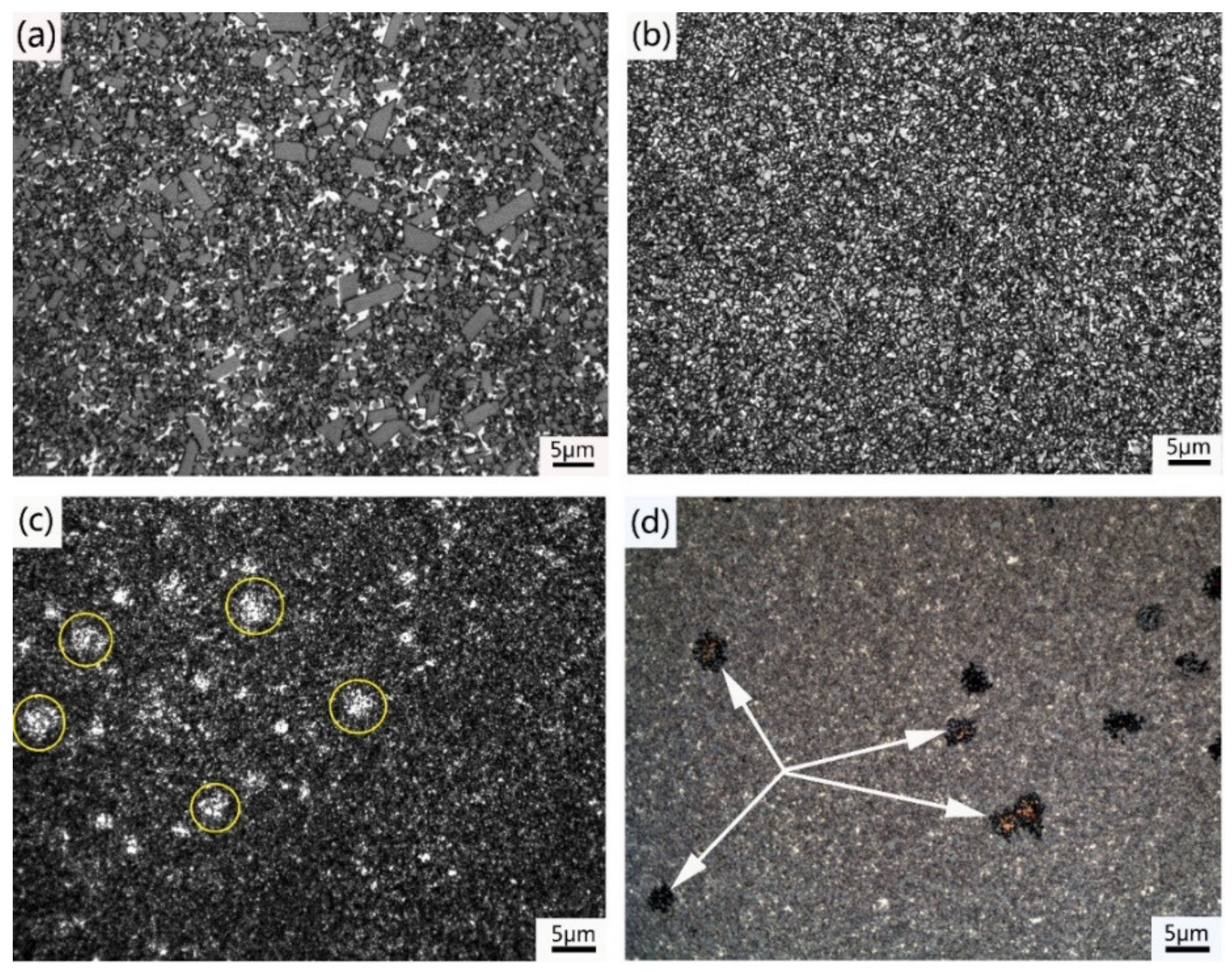
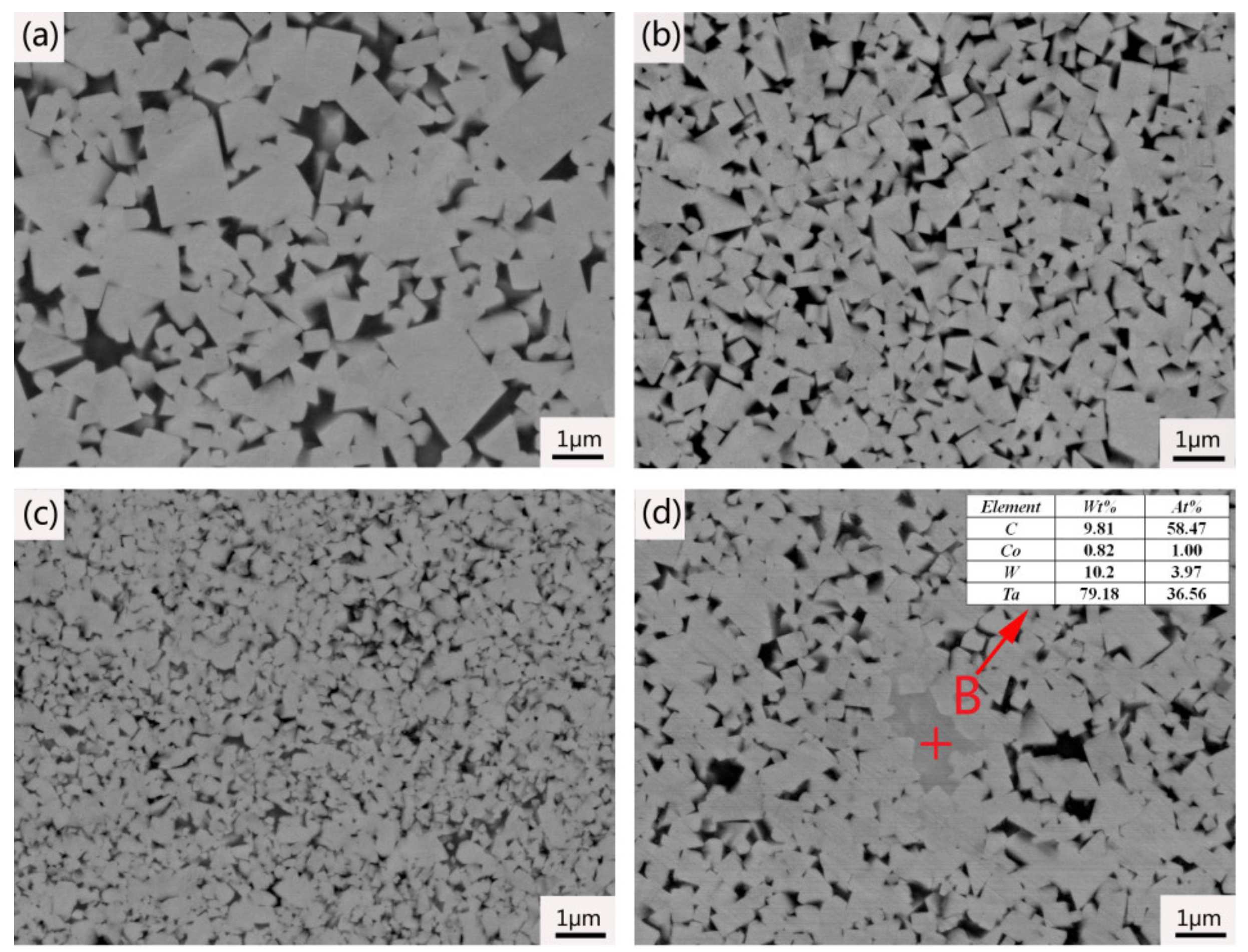
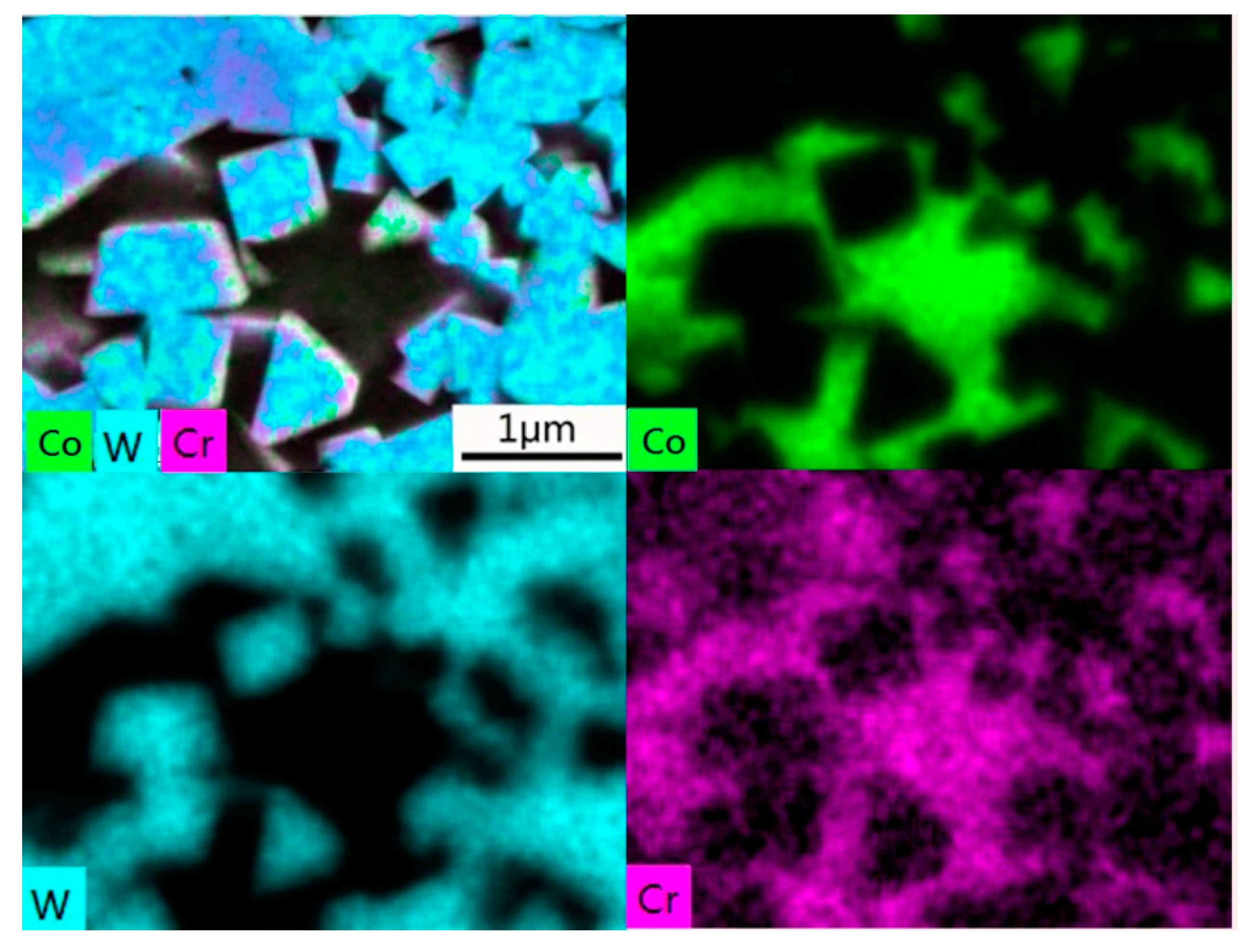
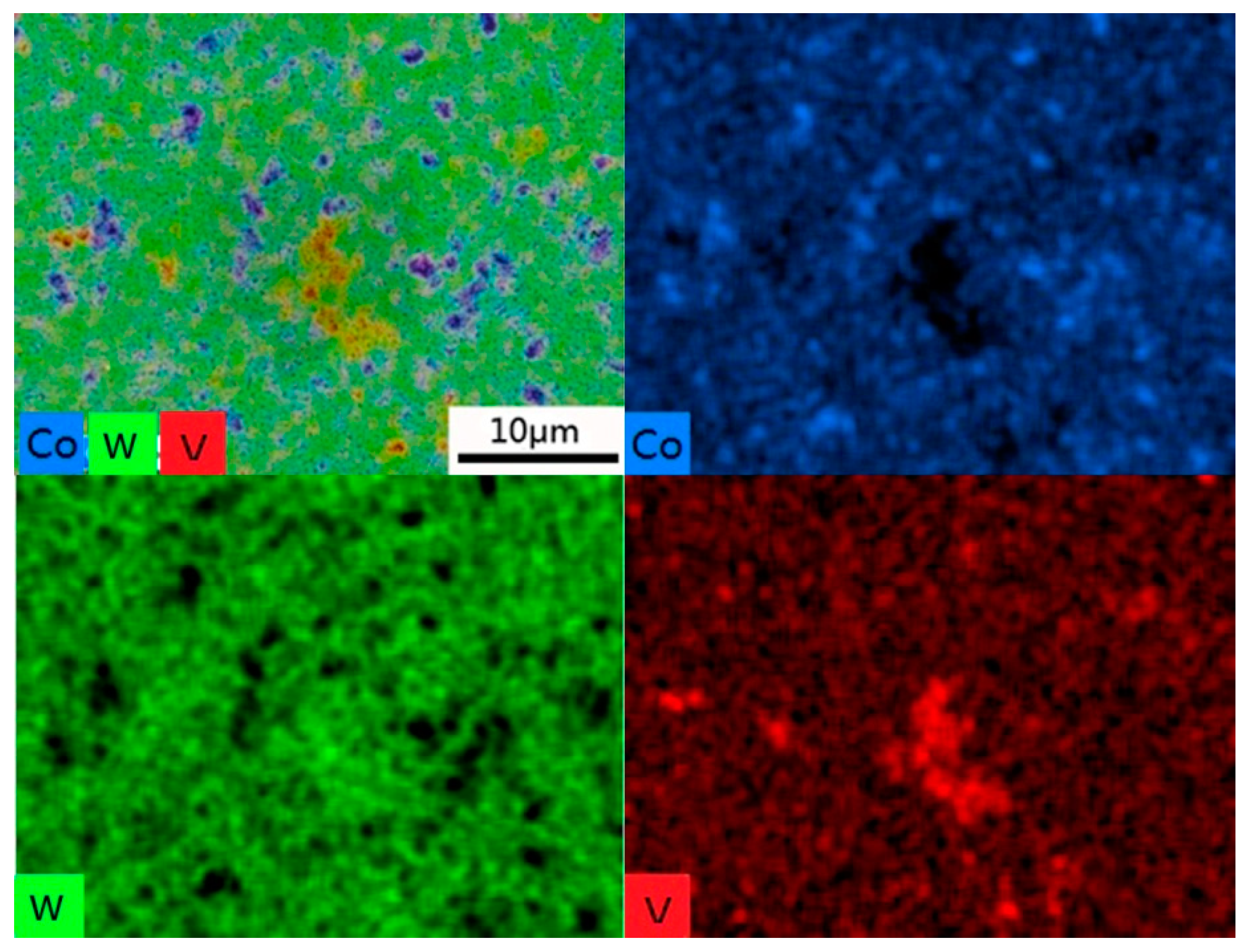
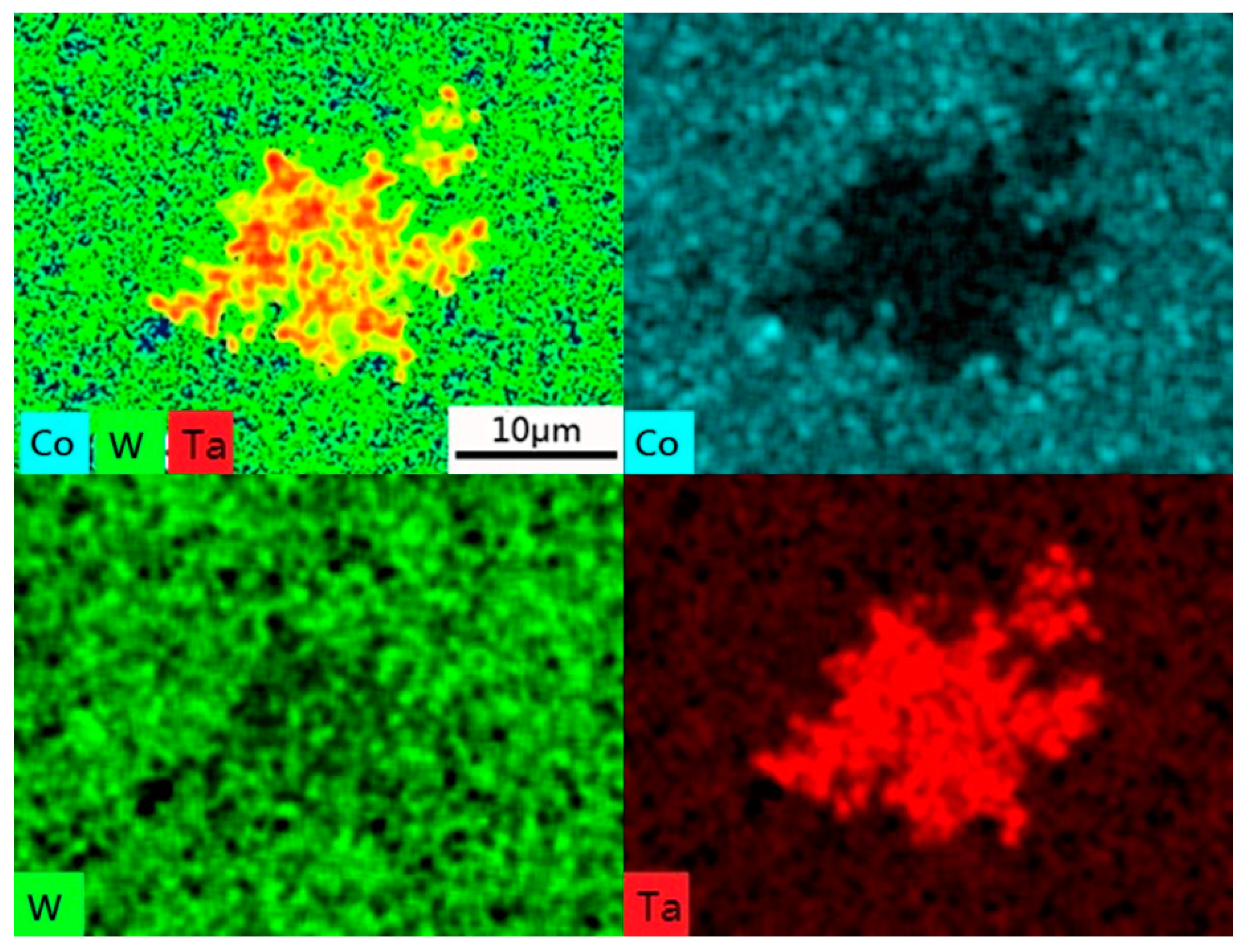
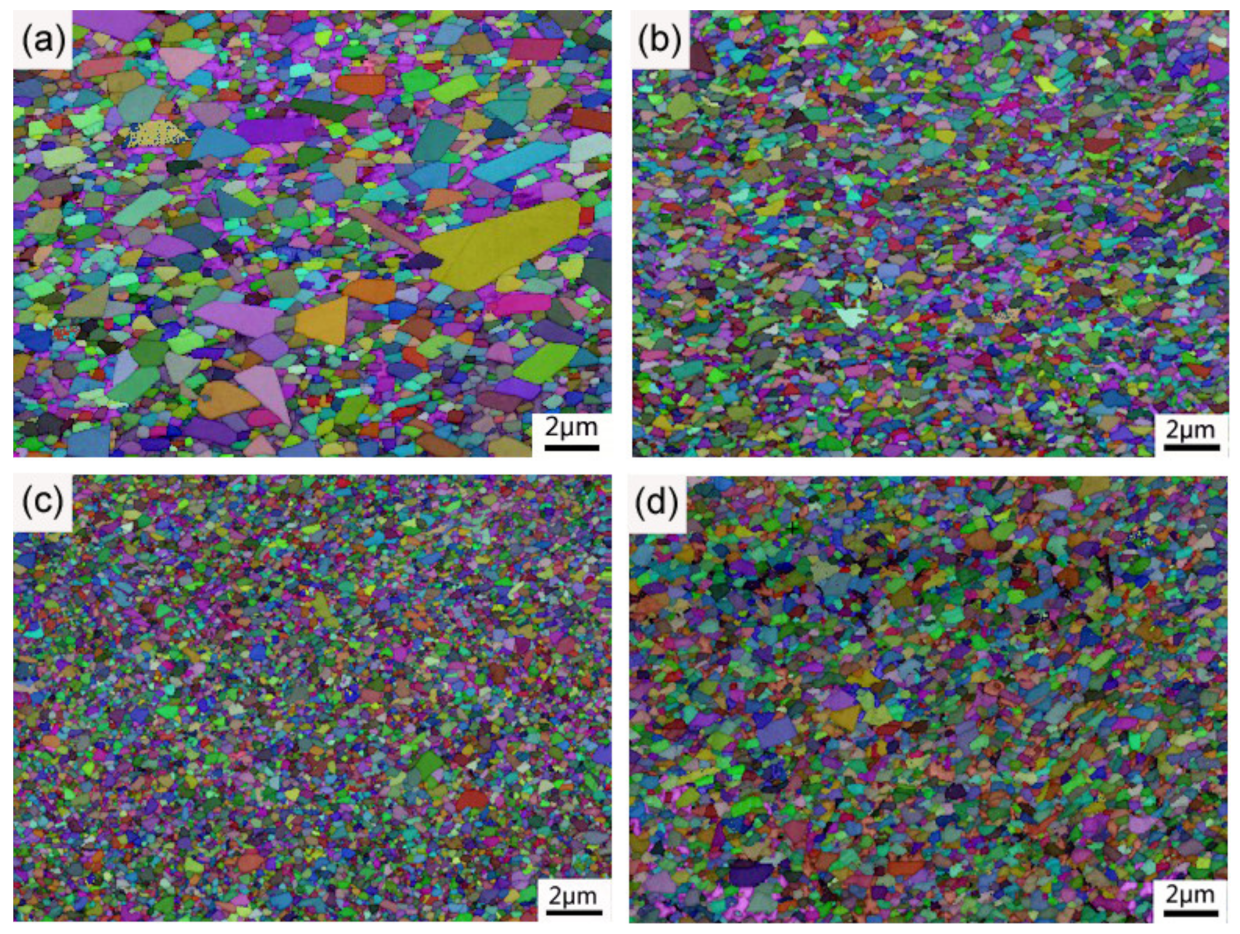

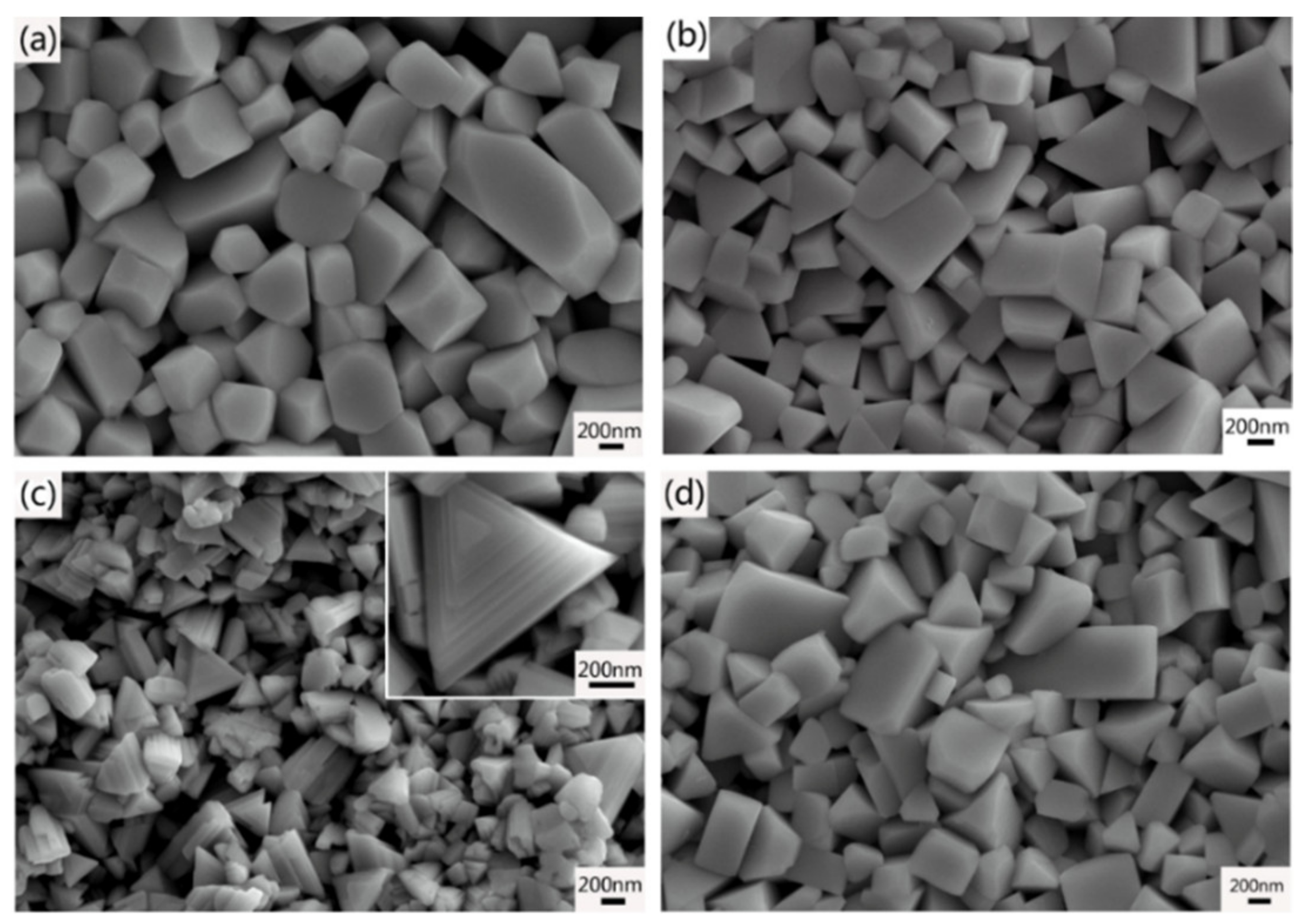
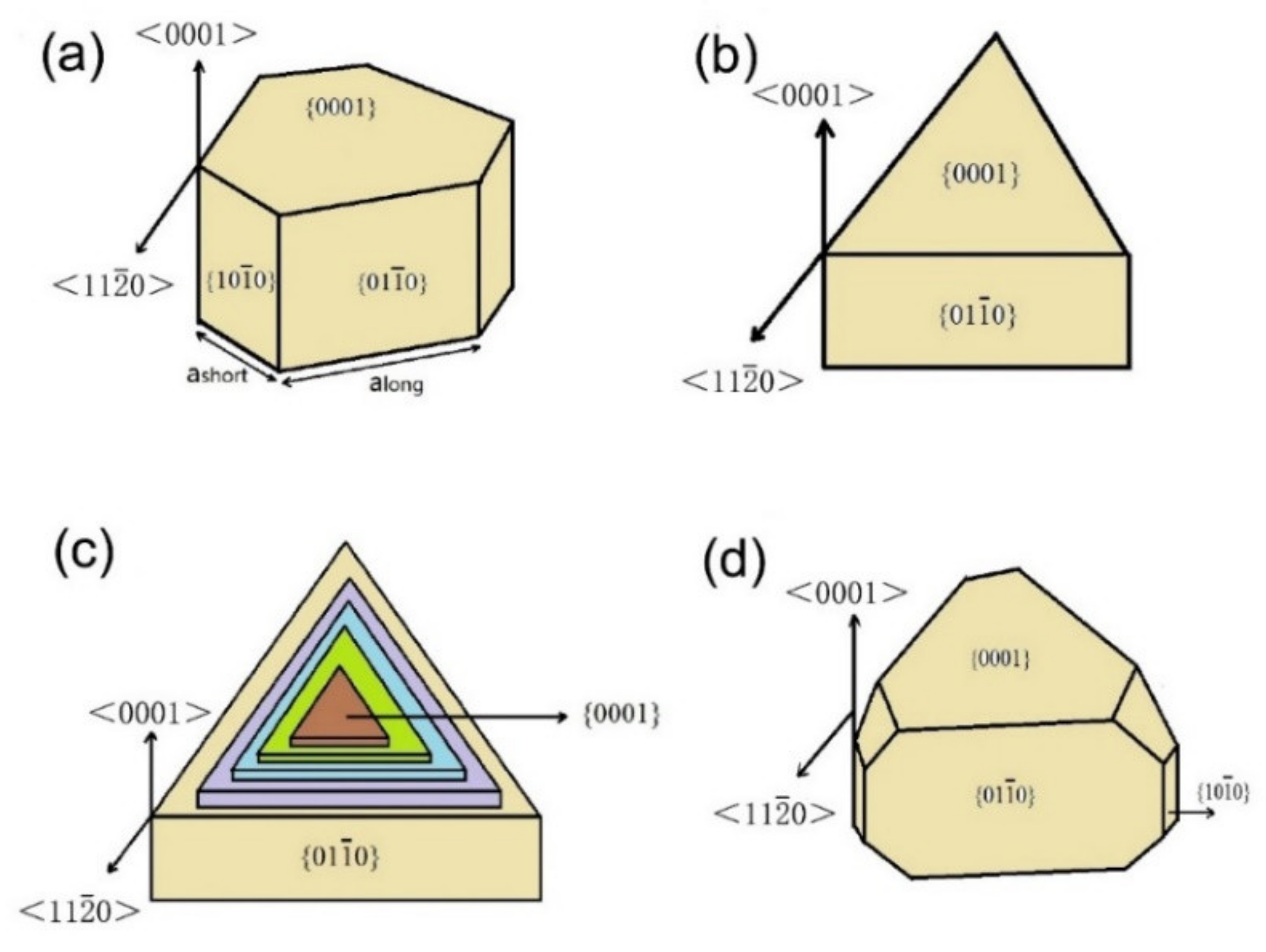
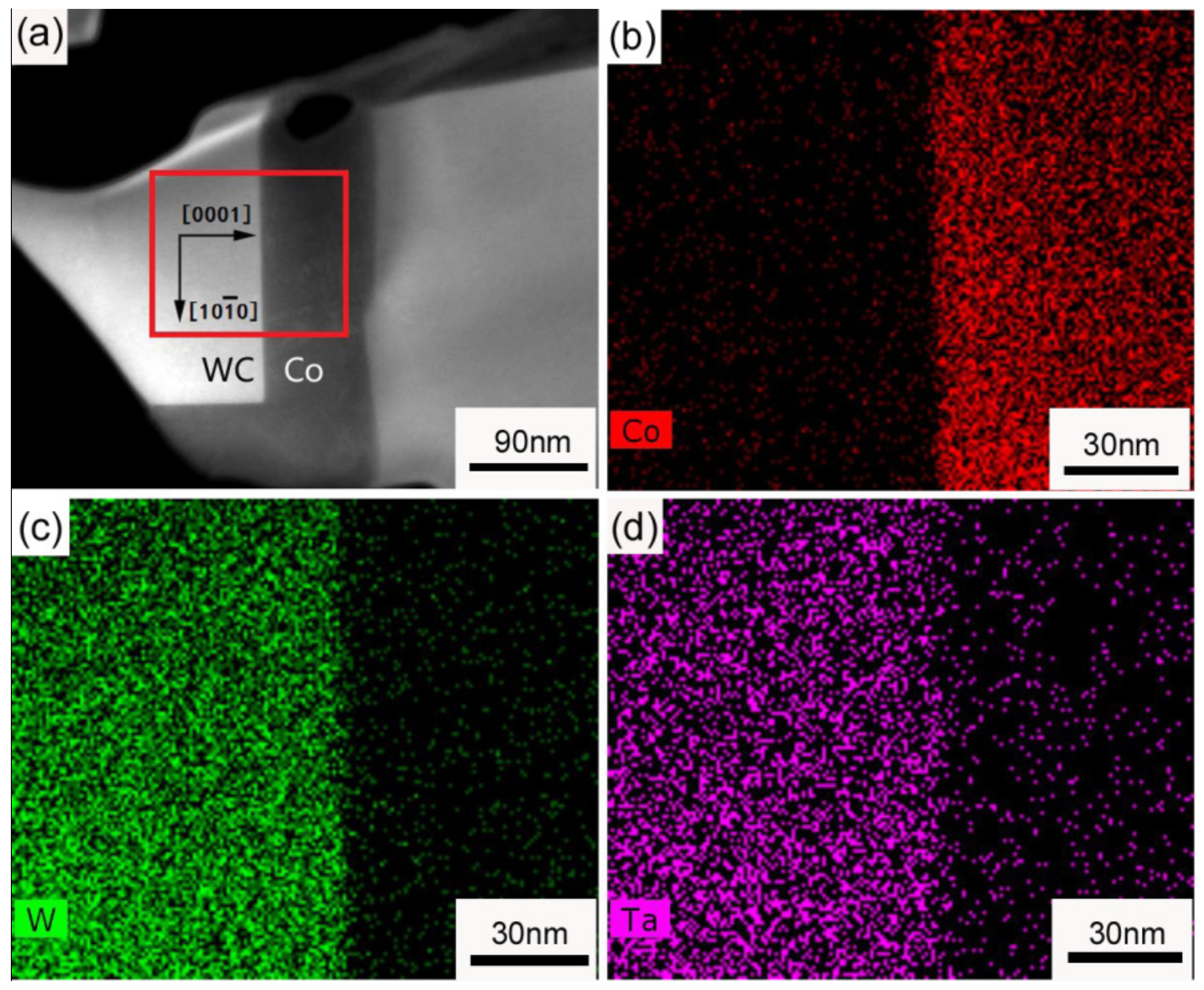
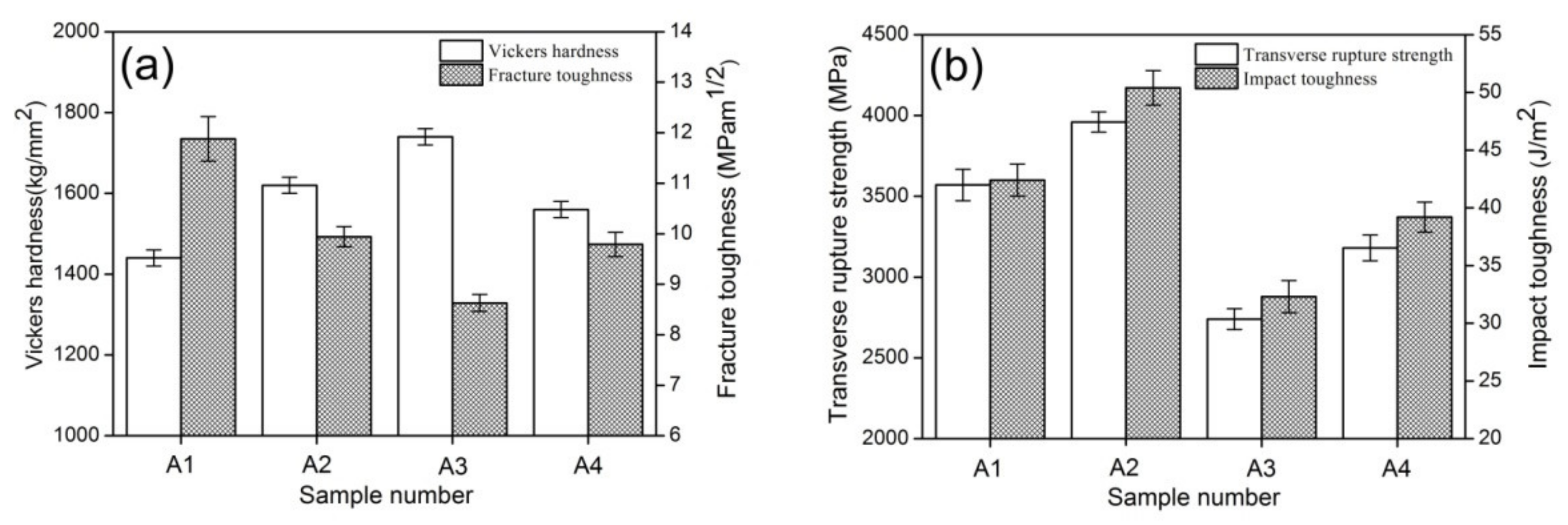
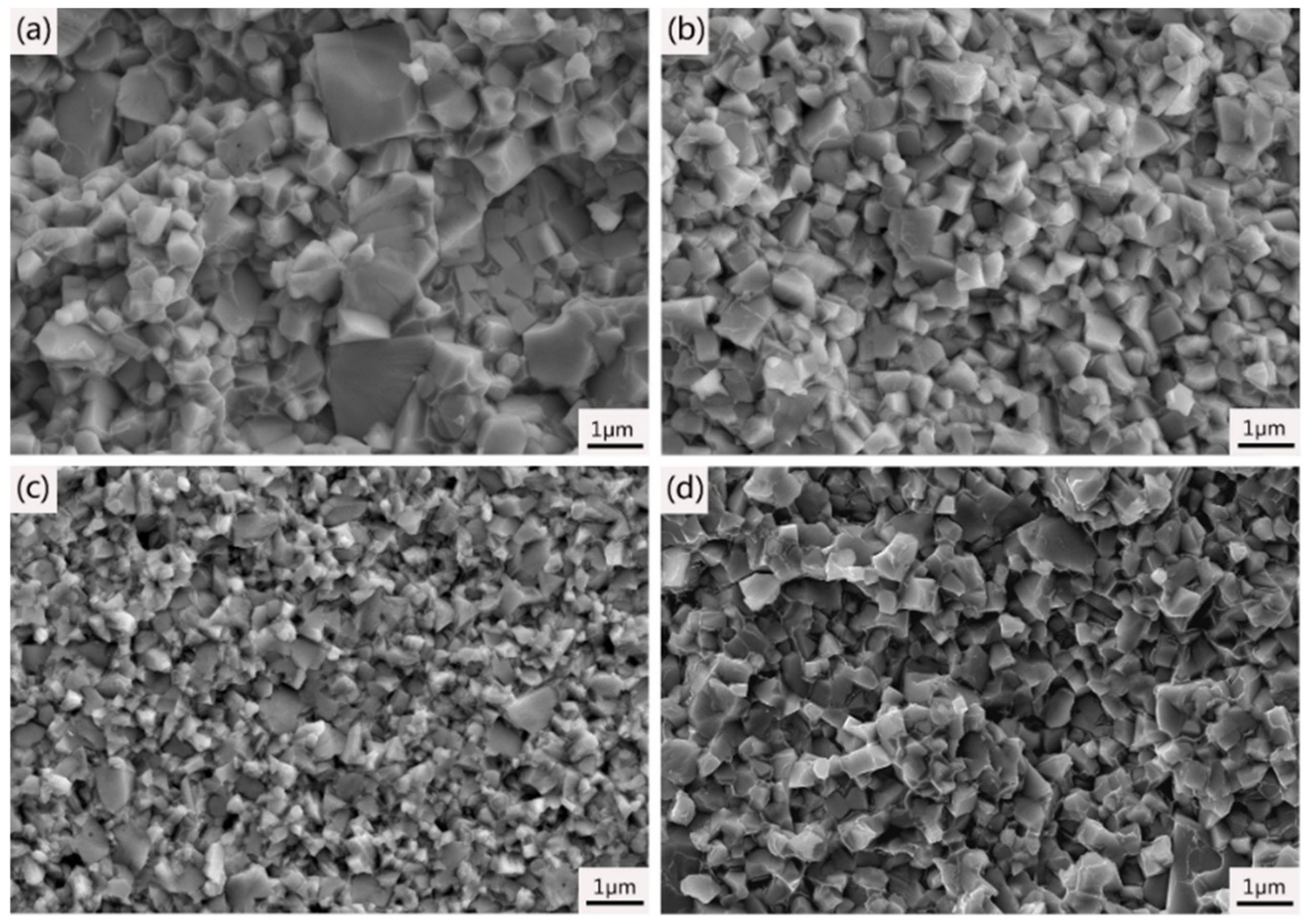
| Material Powder | Fisher Subsieve Sizer/μm | Purity/wt. % | Total Carbon Content/wt. % | Oxygen Content/wt. % |
|---|---|---|---|---|
| WC | 0.60 | 99.65 | 6.20 | 0.15 |
| Co | 1.01 | 99.95 | - | 0.40 |
| Cr3C2 | 1.25 | 99.46 | 13.08 | 0.31 |
| VC | 1.05 | 99.53 | 17.64 | 0.81 |
| TaC | 0.97 | 99.56 | 6.25 | 0.12 |
| Cemented Carbides | Number | WC–10Co (wt. %) | Cr3C2 (wt. %) | VC (wt. %) | TaC (wt. %) |
|---|---|---|---|---|---|
| WC–10Co | A1 | 100 | 0 | 0 | 0 |
| WC–10Co–0.8Cr3C2 | A2 | 99.2 | 0.8 | 0 | 0 |
| WC–10Co–0.8VC | A3 | 99.2 | 0 | 0.8 | 0 |
| WC–10Co–0.8TaC | A4 | 99.2 | 0 | 0 | 0.8 |
© 2020 by the authors. Licensee MDPI, Basel, Switzerland. This article is an open access article distributed under the terms and conditions of the Creative Commons Attribution (CC BY) license (http://creativecommons.org/licenses/by/4.0/).
Share and Cite
Yin, C.; Ruan, J.; Du, Y.; Long, J.; Peng, Y.; Li, K. Effects of Cr3C2, VC, and TaC on Microstructure, WC Morphology and Mechanical Properties of Ultrafine WC–10 wt. % Co Cemented Carbides. Metals 2020, 10, 1211. https://doi.org/10.3390/met10091211
Yin C, Ruan J, Du Y, Long J, Peng Y, Li K. Effects of Cr3C2, VC, and TaC on Microstructure, WC Morphology and Mechanical Properties of Ultrafine WC–10 wt. % Co Cemented Carbides. Metals. 2020; 10(9):1211. https://doi.org/10.3390/met10091211
Chicago/Turabian StyleYin, Chao, Jianming Ruan, Yong Du, Jianzhan Long, Yingbiao Peng, and Kai Li. 2020. "Effects of Cr3C2, VC, and TaC on Microstructure, WC Morphology and Mechanical Properties of Ultrafine WC–10 wt. % Co Cemented Carbides" Metals 10, no. 9: 1211. https://doi.org/10.3390/met10091211




